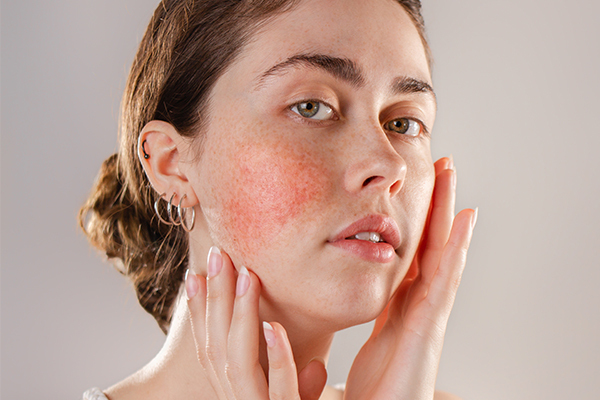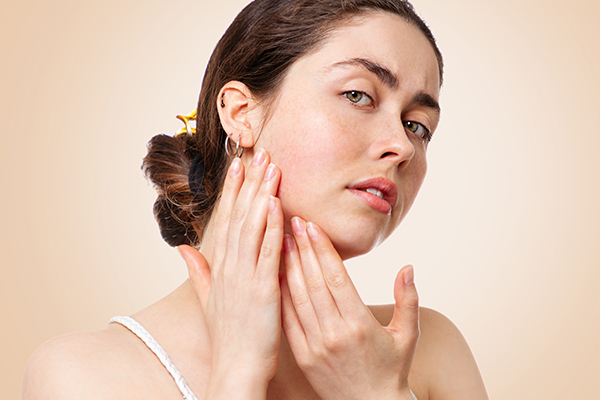This article will discuss some facial symptoms that you should take seriously as they often suggest that something is not right internally.
Here are a few things that your face tells you about your health.
1. Yellowish Skin and Eyes
If your face or the whites of your eyes suddenly develop a pale-yellow tinge, you could be suffering from jaundice or other liver-related problems such as hepatitis or cirrhosis. In fact, yellowing of the skin and eyes is often the first and sometimes the sole symptom of an unhealthy liver.
The liver breaks down dead or damaged red blood cells (RBCs), releasing a yellow pigment called bilirubin as a by-product. If the liver is functioning properly, it will filter out these old RBCs and bilirubin from the healthy blood for elimination.
Liver disease can compromise this function and cause a buildup of bilirubin in the blood and tissue, giving your skin and eyes the yellow tinge. (1)
Moreover, your complexion may acquire a yellowish hue if your gallbladder or pancreas is not working properly.
Additional symptoms of jaundice:
- Fever
- Sudden weight loss
- Diminished appetite
- Abdominal pain
- Itching
- Pale-colored urine and stools
When to see a doctor
Yellowing of the skin or eyes is cause enough to seek immediate medical help for a thorough examination and recommended treatment.
2. Butterfly-Shaped Rash

A butterfly-shaped rash on the face that spreads across both cheeks and resembles sunburnt skin is a characteristic symptom of lupus.
Lupus, short for systemic lupus erythematosus (SLE), is an incurable autoimmune disorder wherein the immune system mistakenly perceives the body’s healthy tissue as a foreign threat and attacks it. This triggers tissue inflammation and damage in different parts of the body, including the skin, joints, heart, kidneys, and other organs. (2)
Additional symptoms of lupus:
- Swollen, tender, painful joints and muscles
- Low-grade fever
- Feeling tired all the time without exertion
- Chest pain
- Labored breathing
- Fluid retention or edema
- Frequent headaches
When to see a doctor
If you develop a butterfly-shaped rash on your face, consult your doctor without delay for a proper diagnosis.
3. Excessive Facial Hair
All women have some degree of facial hair, but it is usually much finer and sparser than that in men and is referred to as peach fuzz.
Androgens are sex hormones that trigger the development of male traits, including facial and body hair. Female bodies also produce trace amounts of androgens, which explains why they tend to have much less hair on the face and body than men.
Women who get heavy male-pattern hair growth along the jawline, chin, and upper lip typically suffer from hormonal conditions that increase androgen levels in their body. Higher androgen levels lead to thicker and coarser hair on the face.
Excessive facial and body hair in women is known as hirsutism. (3) One hormonal disorder that is commonly associated with hirsutism is polycystic ovarian syndrome (PCOS).
Hirsutism can also be a symptom of adrenal gland dysfunction or a side effect of certain medications that cause hormonal imbalances within the body. (4)
4. Pale Skin

Skin that appears unusually washed out could indicate that your body is running low on iron. Your body needs iron to make a protein called hemoglobin, which is an essential part of red blood cells. This protein not only gives your blood its red color (5) but also carries oxygen from the lungs to body tissues, including the skin.
Iron deficiency causes low hemoglobin levels, and this means your tissues will not get enough oxygen through the blood. This condition is referred to as iron-deficiency anemia, and it affects billions of people around the world. (6)
Oxygen-deprived facial skin will inadvertently appear dull and lifeless. In fact, pale-looking skin is one of the most noticeable symptoms of iron-deficiency anemia, which can also reduce the redness of your gums, lower eyelids, and inner side of your lips.
Additional symptoms of iron deficiency:
- Fatigue
- Brittle nails
- Cold hands and feet
- Frequent headaches
- Shortness of breath
5. Dry Skin and Flaky Lips
Everyone suffers from the occasional skin dryness and chapped lips, some more than the others.
Some people are born with naturally dry skin that has to be managed through regular moisturizing and proper skin care. For others, it could be the result of the arid weather (especially during winters) or taking long hot showers, both of which strip the natural moisture from your skin and leave it increasingly dry.
Not drinking enough water on a regular basis can dehydrate your body, including your skin. Water accounts for 30% of your skin’s composition and makes it supple and elastic. (7) Dehydrated skin won’t have enough water to retain these structural characteristics. It will inadvertently be dry, less elastic, and flaky. (8)
Dry skin can also be a sign of underlying conditions such as hypothyroidism, diabetes, and vitamin B deficiency. It is also a common symptom of inflammatory skin conditions such as eczema and dermatitis. (9)
Self-care measures:
- Drink at least 7–8 glasses of water every day to keep your skin and body hydrated.
- Ask your dermatologist to recommend an appropriate moisturizer for your skin type, and use it religiously in your daily skin care regimen.
- Another useful remedy is to gently massage your skin and lips with a thin layer of extra virgin coconut oil.
6. Abnormal Skin Hyperpigmentation
Women who develop thick patches of rough, deeply pigmented skin (brown or black) on their forehead, neck folds, abdomen, underarms, and breasts may be suffering from PCOS. This type of skin pigmentation is known as acanthosis nigricans (10) and is said to be caused by insulin resistance, or elevated insulin levels triggered by PCOS.
A 2011 study published in the Indian Journal of Dermatology states that between 5% and 33% of patients with PCOS have acanthosis nigricans. (11)
7. Deep Premature Wrinkles
Wrinkles are a natural part of skin aging and are bound to occur as you get older. The good news is you can delay or minimize their appearance by looking after your skin and overall health.
Some people develop wrinkles and fine lines early, making them look older than their years. This is known as premature skin aging, which can be triggered by various factors.
Unhealthy behaviors such as smoking can make your skin age faster. This is because tobacco smoke releases a toxic chemical called nicotine into the body that shrinks the blood vessels in the outer layers of the skin, limiting blood flow. As a result, your skin doesn’t get enough oxygen (12) and nutrients through the blood to remain healthy and strong.
Cigarettes also produce more than 4,000 other harmful chemicals that break down the structural proteins that give your skin its strength and elasticity, namely, collagen and elastin. This makes your skin saggy and wrinkly.
Self-care measures:
Quit smoking and avoid second-hand smoke to keep your skin young for longer.
8. Cracks Around the Corners of the Mouth
Drying and cracking of the skin around the corners of the lips are medically referred to as angular cheilitis. This condition is often linked to vitamin B2 or riboflavin deficiency. (13)
Self-care measures:
- Bring up your vitamin B levels by eating foods that are rich in this nutrient, such as eggs, salmon, tuna, oysters, clams, sun-dried tomatoes, Swiss chard, peanuts, beans, and legumes.
- You can also talk to your doctor about starting you on a vitamin B supplement.
9. Puffy Eyes
Sleep deprivation for many nights can make your eyes puffy and cast dark circles around them. (14) Excessive crying can also do the same.
However, puffy eyes could also be a sign of something more serious if it occurs too often and even when you have slept well. For instance, thyroid eye disease (TED) is an autoimmune disorder that causes tissue inflammation around and behind the eyes, which appears on the surface as swelling or puffiness. (15)
Persistently puffy or bulging eyes can also be symptomatic of a thyroid disorder known as Graves’ disease. (16) It could be a result of kidney ailments that trigger swelling all over the body, including around the eyes.
Final Word
The facial symptoms mentioned above do not provide a foolproof diagnosis on their own. They are only to be taken as warning signs that merit further medical investigation for a proper diagnosis. Looking out for these symptoms can help you catch the related disease in its early stages so that it can be treated before it gets serious or chronic.
